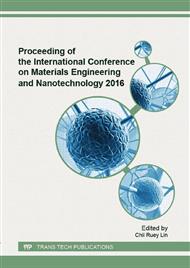[1]
ITRS 2013 Ed, available at www. itrs. net/links/2013ITRS/Home2013. htm.
Google Scholar
[2]
D. Jimenez, B. Iniguez, J. Su, L F. Marsal, J. Pallars, J. Roig, and D. Flores, IEEE Electron. Dev. Lett., 25(7), 571-573 (2004).
DOI: 10.1109/led.2004.831902
Google Scholar
[3]
J. -P. Colinge, Solid State Electron., 48(6), 897–905(2004).
Google Scholar
[4]
B. Yu, W. -Y. Lu, H. Lu, and Y. Taur, IEEE Trans. Electron. Dev., 54(3), 492-496 (2007).
Google Scholar
[5]
G. X. Hu, L. -L. Wang, R. Liu, and T. -A Tang, Commun. Theor. Phys., 54, 763-767 (2010).
Google Scholar
[6]
W. Cao, C. Shen, S. Q. Cheng, D. M. Huang, H. Y. Yu, N. Singh, G. Q. Lo, D. L. Kwong, and M. -F. Li, IEEE Electron Dev. Lett., 32(4) 461-463 (2011).
Google Scholar
[7]
B. Yu, L. Q. Wang, Y. Yuan, P. M. Asbeck, and Y. Taur, IEEE Trans. Electron Dev., 55(11), 2846–2858 (2008).
DOI: 10.1109/ted.2008.2005163
Google Scholar
[8]
R. Han and C. Li, Jpn. J. Appl. Phys, 52, 024302 (2013).
Google Scholar
[9]
S. Lina, Z. Yiqi, L. Cong, and L. Dechang, J. Semicond. 35(3), 034009 (2014).
Google Scholar
[10]
S. M. Amoroso, C. Monzio Compagnoni, A. Mauri, A. Maconi, A. S. Spinelli, and A. L. Lacaita, IEEE Trans. Electron. Dev., 58(9), 3116-3126 (2011).
DOI: 10.1109/ted.2011.2159010
Google Scholar
[11]
F. Chaves, D. Jimenez, and J. Sune, Solid State Electron. 68, 93-97 (2012).
Google Scholar
[12]
F. Chaves, D. Jimenez, and J. Sune, Solid State Electron. 76, 19-24 (2012).
Google Scholar
[13]
C. Bimo, F. A. Noor, and Khairurrijal, Compact modeling of quantum effects in undoped long-channel cylindrical surrounding-gate MOSFETs, in Asian Physics Symposium 2015 (Bandung, August 19-20, 2015).
DOI: 10.1088/1742-6596/739/1/012025
Google Scholar
[14]
C. Bimo, F. A. Noor, and Khairurrijal, Modeling of Electron Leakage Current in Undoped Cylindrical Surrounding-Gate MOSFETs, (submitted to elsewhere).
DOI: 10.1088/1742-6596/739/1/012025
Google Scholar
[15]
T. Kauerauf, B. Govoreanu, R. Degraeve, G. Groeseneken, and H. Maes, Solid State Electron., 49(5), 695-701 (2005).
DOI: 10.1016/j.sse.2005.01.018
Google Scholar
[16]
H. K. Tyagi, B. Prasad, P. J. George, Phys. Status Solidi C, 6(12), 2750- (2009).
Google Scholar
[17]
F. A. Noor, M. Abdullah, Sukirno, Khairurrijal, A. Ohta, and S. Miyazaki, J. Appl. Phys., 108(9), 093711-1/4 (2010).
Google Scholar


